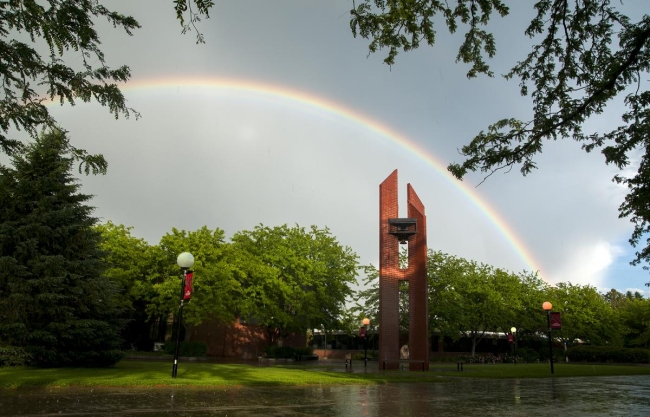You have /5 articles left.
Sign up for a free account or log in.

A rainbow falls over Northwest College's campus. The community college has an endowment of $42 million.
Courtesy of Northwest College
Large endowments often make headlines in higher education, but it's rare to see a community college in the mix.
That doesn't mean two-year colleges avoid fundraising, though.
"Within the last couple of decades, [community colleges] have by and large started to come into their own by recognizing the power of fundraising," said Marc Westenburg, director of the Center for Community College Advancement at the Council for Advancement and Support of Education.
According to the council's data, which was adjusted for inflation, between 1998 and 2018 the average community college endowment grew by 76 percent.
Westenburg said the colleges are realizing "the incredible case they have" for donors. At the same time, he said, the traditional model of funding for these colleges -- with a third of the money coming from state appropriations -- is becoming more of a challenge, as funding in most states has failed to keep pace with enrollment growth, meaning community colleges have to diversify their revenue sources.
At Northwest College in Wyoming, for example, the foundation has an endowment of $42 million, which is larger than the endowments of some small private four-year colleges.
The regional two-year college of 1,500 students got a jump start on its endowment funds in 2004, when the state provided matching gifts for fundraising, said Shelby Wetzel, executive director of the college's foundation. That program alone raised $16 million.
While the state no longer matches donations, Wetzel said the college has built a consistent fundraising program on their own because "donors have fallen in love with helping students."
"A large gift to a large institution is a drop in the bucket so many times," she said. "A large gift to our institution has huge value."
About 80 percent of the endowment is allocated to scholarships. It produces about $1.3 million annually in income to dole out to 1,500 students, Wetzel said.
Most of the money comes from nonalumni in the community, she said. Because the college is in a rural area, it provides a residential experience, which trickles out to the community through sporting events and cultural enrichment. The foundation uses those attributes to build the case for the college's value to the community.
The college is also the fifth-largest employer in the county, according to Wetzel. An economic modeling study found that it has an $88 million annual impact on the region.
Donors "can see their dollar goes further here," she said.
For the college, the endowment gives breathing room for dealing with budget cuts. For example, when state budget slashing hit during the recession, the foundation absorbed all of the scholarship funds normally taken out of the college's general fund. This freed up money for the college to use to counteract the cuts.
Northwest College makes a case against what Westenburg refers to as myths surrounding community college endowments.
One is that community college alumni don't have the same strong ties or pride for their past colleges as do graduates of four-year colleges.
"It's simply not true," Westenburg said. "For most community colleges, between 60 and 80 percent of their students remain in their service districts."
Because alumni are still active in these communities, they are more likely to give. A study by Lisa Skari, president of Mt. Hood Community College in Oregon, found that alumni who gave to the four-year college they transferred to were also four times more likely to give to their community college.
Linnie Carter, executive director of the Harrisburg Area Community College Foundation in Pennsylvania, said that statistic also helps encourage donors to give to community colleges.
"Donors’ charitable investments have a direct impact on their own communities, because the beneficiaries of their generosity are productive members of society," Carter said. "A donor who contributes to a scholarship fund is investing in a nurse who might save their life one day."
While Carter said it's more difficult for community colleges to fundraise simply because they have fewer resources than four-year institutions, and they are typically younger institutions and thus have smaller alumni pools, it can still be done. Her college's foundation has about $43 million in assets, she said.
One donor, Gloria Paxton, left 70 percent of her estate -- $1.3 million -- to the college last year. She wasn't an alumna, Carter said, but she still understood the importance of the college.
Carter also emphasizes the economic impacts of the college. A study found that the college generates $1 billion annually through its operations, construction projects, student spending and alumni. It also supports more than 14,000 jobs in the area.
"We ask donors to imagine life without HACC, and it’s impossible," Carter said. "There’s no mission in higher education that's more important than the community college mission, in my opinion."








